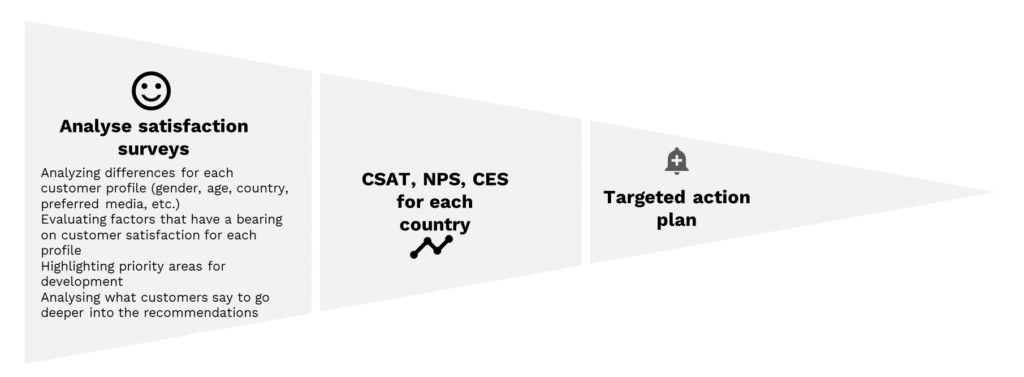8 simple tips to improve customer satisfaction in a multicultural and multilingual environment
What levers are essential for customer satisfaction? How can a “customer-centric” strategy be implemented within a multilingual and multicultural environment?
Key indicators are used to drive a customer-centric strategy. These include the NPS (Net Promoter Score), CES (Customer Effort Score) and CSAT (Customer Satisfaction Score). These assess whether brand interactions fully meet customer expectations.
They also provide valuable and critical data to act on customer experience friction points, improve customer services and maximize value creation opportunities.
Here are eight simple tips to increase your NPS, CES and CSAT scores, and therefore customer satisfaction, within a complex environment:

1. Immerse Customer Service Representatives in the world of the brand
Creating a work environment that reflects your brand’s world will contribute to your advisers’ sense of belonging. If advisers take ownership of this brand world and mindset, they’ll be able to share it with customers during their interactions.
How do I do this?
- Customize the layout of your production spaces.
- Create a visual world to bring your advisers on board and immerse them in it.
- Optimize the employee experience using designated places for sharing, developing and expressing talent.
2. Build an experiential and immersive training program focusing on interaction and customer satisfaction
Before getting into production, advisers must have a good understanding of the brand world and customers’ cultural specificities so they can best respond to them, engaging in spontaneous and fair discussions.
How do I do this?
- Pass on brand codes (signature and relationship fundamentals).
- Develop self-confidence and ensure advisers have a mature understanding of customer expectations.
- Integrate customer culture-focused modules into training pathways.
- Create sustainable value by combining training and practice.
- Identify advisers who can act as mentors to share best practices.
3. Be daring in your use of Virtual Reality
“Learning is an experience”: advisers need to be really well versed in the brand experience through their own immersion at the heart of your services. This is the key to facilitating their understanding and anchoring their behaviours over time. The distance between customer services and manufacturing, shipping and quality control premises (etc.) does not, however, always allow for this immersion.
How do I do this?
Develop virtual reality capsules for in-situ distance learning, for example:
- To learn about quality control and item authentication processes, really getting a sense of this atmosphere.
- To explore the supply chain through a virtual reality warehouse tour, gaining an understanding of the entire order and return preparation process.
- To get to know what underpins the brand’s activities – its hidden side.
4. Customize skills development support
The skills development phase should be accompanied by career path customization in line with the cultures addressed.
How do I do this?
- Place advisers at the centre of performance management focusing on their CSAT & FCR (First Call Resolution) results.
- Propose differentiated action plans in line with individual results.
5. Master cultural specificities to satisfy every customer
It’s important to be aware of particularities relating to the multitude of brands and products sold, along with buyer profiles, tastes and expectations in every country.
How do I do this?
Conduct country-specific satisfaction surveys:
- Efficiency levels: satisfaction, NPS, 1st contact resolution and CES (Customer Effort Score).
- Quality of service for the contact processed (waiting time, clarity of response, etc.).
- Pre and post-contact customer pathway, including multi-channel response-seeking behaviour.
- Repeat measurement.
6. Cross-reference KPIS and customer satisfaction surveys for each country
Customer expectations and satisfaction levels are not necessarily consistent across countries, hence the need for separate action plans.
How do I do this?
- Consider the customer satisfaction issues for each channel at every stage of the journey for each country/market.
- Create action plans that take into account cultural specificities, annoyances and customer expectations.
- Take ownership of lexical fields by developing a MOOC and workshops dedicated to identifying customer typology (men/women, age, consumption habits, etc.), along with key arguments using customer identification and typology.
- Drive quality through the customer experience, individuality, top sales and loyalty.

7. Create a team of ambassadors with “outperforming agents”
Retaining our teams of advisers is a real issue. It’s a question of keeping the best talent, pushing them to give their best by giving them a leading role.
How do I do this?
- Build a strong community of expert advisers who’ll become brand ambassadors for your teams.
- Develop a programme to reward top talent in an environment that encourages motivation.
- Involve the ambassadors in creating a newsletter: sharing experiences, tips and best practices for each country, brand spirit and culture, top 10 most sought-after products, reasons for satisfaction and annoyances, etc.
8. Boost team engagement, quality and performance through gamification
The aim is to make work more collaborative and exciting by creating positive competition based on play.
How do I do this?
Deploy a dedicated social network for your advisers, with tools for driving and developing team spirit:
- Challenges, competitions, battles, etc.
- Real-time performance monitoring
- Personalized goodies and rewards package
- Real-time communication: news, urgent information, etc.